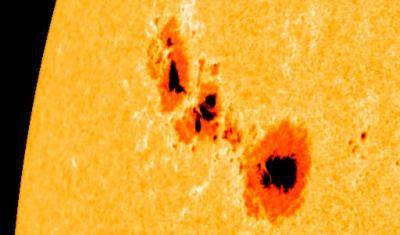Behemoth sunspot 1302 unleashed another strong flare on Saturday morning--an X1.9-category blast at 5:40 am EDT. NASA's Solar Dynamics Observatory (SDO) recorded the extreme ultraviolet flash.
A NASA SDO movie shows a shadowy shock wave racing away from the blast site. This is a sign that the blast produced a coronal mass ejection (CME) that could deliver a glancing blow to Earth's magnetic field on Sept. 26.
Active Region 1302 unleashes an X1.9-category solar flare at 5:40 am EDT on Sept. 24, 2011. NASA's Solar Dynamics Observatory (SDO) recorded the extreme ultraviolet flash in composite wavelengths (211, 193, 171 angstrom). Note: The sun has been rotated 90 degrees clock-wise for better video presentation.
(Photo Credit: NASA/SDO/GOES)
Since the X1.9-flare, active region (AR) 1302 has unleashed M8.6 and M7.4 flares on Sept. 24 and an M8.8 flare early on Sept. 25. None of the blasts have been squarely Earth-directed, but this could change as the sunspot turns toward our planet in the days ahead. AR1302 is growing and shows no immediate signs of quieting down.

Sunspot 1302 has already produced two X-flares (X1.4 on Sept. 22 and X1.9 on Sept. 24th). Each of the dark cores in this image from SDO is larger than Earth, and the entire active region stretches more than 100,000 km from end to end. The sunspot's magnetic field is currently crackling with sub-X-class flares that could grow into larger eruptions as the sunspot continues to turn toward Earth.(Photo Credit: NASA/SDO/HMI)Source: NASA/Goddard Space Flight Center